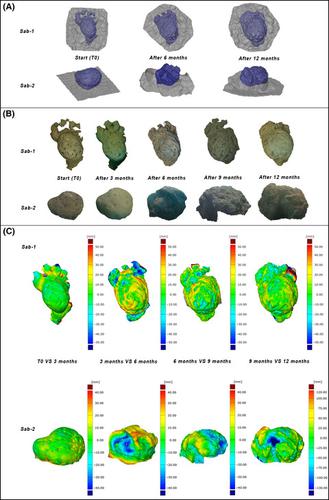当前位置:
X-MOL 学术
›
Remote Sens. Ecol. Conserv.
›
论文详情
Our official English website, www.x-mol.net, welcomes your
feedback! (Note: you will need to create a separate account there.)
Integration of close-range underwater photogrammetry with inspection and mesh processing software: a novel approach for quantifying ecological dynamics of temperate biogenic reefs
Remote Sensing in Ecology and Conservation ( IF 3.9 ) Pub Date : 2020-10-07 , DOI: 10.1002/rse2.178 Daniele Ventura 1 , Stanislas F. Dubois 2 , Andrea Bonifazi 3 , Giovanna Jona Lasinio 4 , Marco Seminara 1 , Maria F. Gravina 3, 4, 5 , Giandomenico Ardizzone 1
Remote Sensing in Ecology and Conservation ( IF 3.9 ) Pub Date : 2020-10-07 , DOI: 10.1002/rse2.178 Daniele Ventura 1 , Stanislas F. Dubois 2 , Andrea Bonifazi 3 , Giovanna Jona Lasinio 4 , Marco Seminara 1 , Maria F. Gravina 3, 4, 5 , Giandomenico Ardizzone 1
Affiliation

|
Characterizing and monitoring changes in biogenic 3-dimensional (3D) structures at multiple scales over time is challenging within the practical constraints of conventional ecological tools. Therefore, we developed a structure-from-motion (SfM)-based photogrammetry method, coupled with inspection and mesh processing software, to estimate important ecological parameters of underwater worm colonies (hummocks) constructed by the sabellariid polychaete Sabellaria alveolata, using non-destructive, 3D modeling and mesh analysis. High resolution digital images of bioconstructions (hummocks) were taken in situ under natural conditions to generate digital 3D models over different sampling periods to analyse the morphological evolution of four targeted hummocks. 3D models were analysed in GOM Inspect software, a powerful and freely available mesh processing software to follow growth as well as morphology changes over time of each hummock. Linear regressions showed 3D models only slightly overestimated the real dimensions of the reference objects with an average error < 5% between measured and model-estimated dimensions for both length and volume. Manual inspection of models and semi-automated surface-to-surface comparison allowed the computation of important metrics linked to the ecology of temperate reefs such as volume, surface area, surface complexity/rugosity, number and size of holes and creeks and the mean density of living worms per colony. Moreover we demonstrated the reliability of 3D surface complexity estimates against two linear rugosity measures: a traditional and a virtual variant of the ‘chain-and-tape’ method. Finally, besides 3D models deviation analysis via surface comparison, a Bayesian latent variable model approach was adopted to highlight the significative effects of sea state conditions on S. alveolata hummocks metrics. We demonstrated without damaging the benthic organisms that SfM approach allow continuous study of temperate bioconstruction leading to a fine description of short-term structural modification mediated by hydrodynamics, making this technique accessible and repeatable to many other areas of ecological research.
中文翻译:

近距离水下摄影测量与检查和网格处理软件的集成:一种量化温带生物礁生态动态的新方法
在传统生态工具的实际限制内,表征和监测多个尺度的生物 3D (3D) 结构随时间的变化具有挑战性。因此,我们开发了一种基于运动结构(SfM)的摄影测量方法,结合检查和网格处理软件,使用非破坏性估计由 sabellariid polychaete Sabellaria alveolata构建的水下蠕虫群(小丘)的重要生态参数。, 3D 建模和网格分析。生物结构(小丘)的高分辨率数字图像是原位拍摄的在自然条件下生成不同采样周期的数字 3D 模型,以分析四个目标小丘的形态演变。3D 模型在 GOM Inspect 软件中进行分析,该软件是一款功能强大且免费提供的网格处理软件,可跟踪每个小丘随时间的生长和形态变化。线性回归显示 3D 模型仅略微高估了参考对象的实际尺寸,长度和体积的测量尺寸和模型估计尺寸之间的平均误差 < 5%。模型的手动检查和半自动的地表比较允许计算与温带珊瑚礁生态相关的重要指标,例如体积、表面积、表面复杂性/粗糙度、孔洞和小溪的数量和大小以及平均密度每个菌落的活蠕虫数。此外,我们证明了 3D 表面复杂性估计相对于两种线性粗糙度测量的可靠性:“链和胶带”方法的传统和虚拟变体。最后,除了通过表面比较进行 3D 模型偏差分析之外,还采用贝叶斯潜变量模型方法来突出海况条件对S. alveolata小丘指标。我们证明了在不损害底栖生物的情况下,SfM 方法允许对温带生物结构进行持续研究,从而对由流体动力学介导的短期结构修改进行精细描述,使该技术可用于许多其他生态研究领域并可重复使用。
更新日期:2020-10-07
中文翻译:

近距离水下摄影测量与检查和网格处理软件的集成:一种量化温带生物礁生态动态的新方法
在传统生态工具的实际限制内,表征和监测多个尺度的生物 3D (3D) 结构随时间的变化具有挑战性。因此,我们开发了一种基于运动结构(SfM)的摄影测量方法,结合检查和网格处理软件,使用非破坏性估计由 sabellariid polychaete Sabellaria alveolata构建的水下蠕虫群(小丘)的重要生态参数。, 3D 建模和网格分析。生物结构(小丘)的高分辨率数字图像是原位拍摄的在自然条件下生成不同采样周期的数字 3D 模型,以分析四个目标小丘的形态演变。3D 模型在 GOM Inspect 软件中进行分析,该软件是一款功能强大且免费提供的网格处理软件,可跟踪每个小丘随时间的生长和形态变化。线性回归显示 3D 模型仅略微高估了参考对象的实际尺寸,长度和体积的测量尺寸和模型估计尺寸之间的平均误差 < 5%。模型的手动检查和半自动的地表比较允许计算与温带珊瑚礁生态相关的重要指标,例如体积、表面积、表面复杂性/粗糙度、孔洞和小溪的数量和大小以及平均密度每个菌落的活蠕虫数。此外,我们证明了 3D 表面复杂性估计相对于两种线性粗糙度测量的可靠性:“链和胶带”方法的传统和虚拟变体。最后,除了通过表面比较进行 3D 模型偏差分析之外,还采用贝叶斯潜变量模型方法来突出海况条件对S. alveolata小丘指标。我们证明了在不损害底栖生物的情况下,SfM 方法允许对温带生物结构进行持续研究,从而对由流体动力学介导的短期结构修改进行精细描述,使该技术可用于许多其他生态研究领域并可重复使用。











































 京公网安备 11010802027423号
京公网安备 11010802027423号